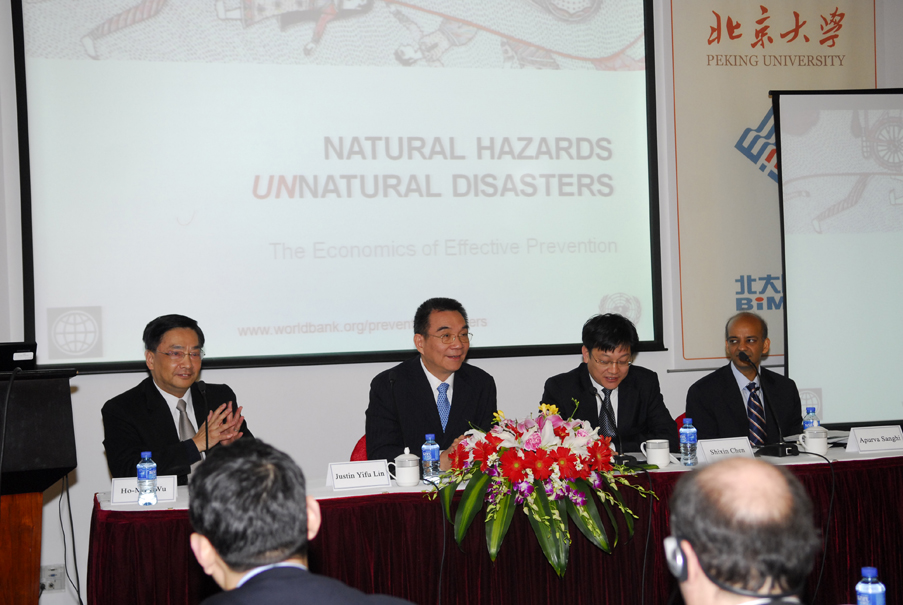Peking University, Mar. 22, 2011: Specialists convened at the China Center for Economic Research (CCER) for the China launch of a joint World Bank-United Nations report on Monday, showing how preventive measures can lower vulnerability to natural hazards such as earthquakes, storms, floods and droughts. Natural Hazards, Unnatural Disasters: the Economics of Effective Prevention, first released last November, estimates that the number of people exposed to storms and earthquakes in large cities could double to 1.5 billion by 2050.

Damages from disasters can be catastrophic, as the world is witnessing now in the tragic aftermath of Japan’s quake and tsunami. However, prevention is critical, a lesson that surely saved many lives in Japan.
According to the report, by 2100, even without climate change, damages from weather-related hazards may triple to US$185 billion annually and factoring in climate change could push costs even higher. In the case of tropical cyclones it would add another US$28-68 billion, says Natural Hazards. But the report argues that much can be done to reduce the toll from such hazards—even in the face of increased risk from climate change.
“A deeper questioning of what happened, and why, could prevent a repetition of disasters,” says the report, a two-year collaboration of climate scientists, economists, geographers, political scientists and psychologists.
“The report could not be timelier, when various countries—both developed and developing—are suffering from the devastating impacts of natural hazards,” said Professor Justin Lin Yifu, the World Bank’s Senior Vice President and Chief Economist. “Preventing and managing disasters is as much a development issue as a humanitarian one. That fundamental understanding underpins this analysis, which goes a long way in changing mindsets towards a culture of prevention.”
Cost-Effective Measures Possible
A central message of the report is that “prevention pays, but you don’t always have to pay more for prevention”. Cost-effective preventive measures include greater access to hazard-related information and regulatory changes to remove distortions, such as abolishing rent and price controls and providing secure titles to encourage better repair and upkeep of buildings. The report also proposes cost-effective, hazard-specific infrastructure: for example, schools that double as cyclone shelters or roadways that double as drains. Sometimes increased spending is warranted—for example to develop and maintain early warning systems—and “even modest increases, and greater sharing of data internationally, can have enormous benefits”, says the report.
“We all know in principle that prevention is better than cure, but we don’t often do much about it, either in our personal lives or in government,” said Sir John Holmes, former UN Undersecretary General for Humanitarian Affairs and Emergency Relief Coordinator, speaking at the Beijing event. “Thisreport shows both how much we need to do, and how best to go about deciding what to do, in order to save lives and reduce future spending. It’s indispensable reading for all governments.”
Lessons for China
China is a high risk country, susceptible to all natural hazards. In 2010 alone, earthquakes killed 2,968 people in April, floods killed 1,691 people over the summer, and a further 1,765 were killed by mudslides, landslide or rock fall triggered by heavy rains and floods in August. Floods and landslides that hit China during the summer are estimated to have cost US$18 billion.
There is much that China is already doing to help lessen the impact of natural hazards. It should continue developing and improving hazard maps and early warning systems and disseminate information to decision makers and communities. As China urbanizes rapidly, and more and more property is exposed, it is also important for China to consider insurance and other risk financing mechanisms.
“Integrating disaster prevention with development planning and sectoral strategies makes sense for China and other countries at high risk of natural hazards,” said Klaus Rohland, World Bank Country Director for China. “As China is investing heavily in the expansion of its infrastructure and public services, as the report suggests, we must ensure that new infrastructure does not introduce unnecessary new risk. This is particularly important since infrastructure investment is long-lived capital stock, and it is imperative that we consider the risks of such investments.”
Looking ahead, the report estimates that, by the turn of the century, China could be one of the three worst affected countries from climate change-induced tropical cyclones. According to the report, three countries are expected to bear 90 percent of global damages: the United States (US$30 billion), Japan (US$10 billion) and China (US$9 billion).
“However, while we recognize the challenges of the future, we’re not alarmist about it. Doing a better job at preventing disasters today will greatly help prevent disasters tomorrow. And we’re not doing enough today,” says Apurva Sanghi, a World Bank Senior Economist and Report Team Leader.
The report was funded by the Global Facility for Disaster Reduction and Recovery, a partnership of 35 countries and six international organizations, including the World Bank, which helps developing countries reduce their vulnerability to natural hazards and adapt to climate change.
Extended Reading:
China Center for Economic Research (CCER)
Edited by: LI Xiaomeng
Source: BiMBA